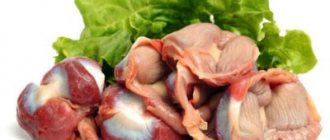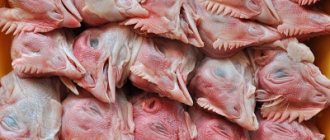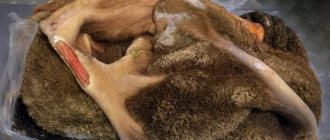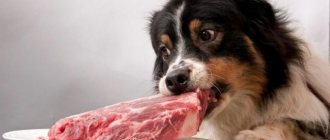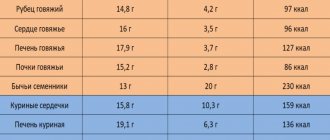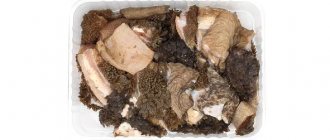Dogs are carnivores with very specific digestive systems. They need to have ingredients containing animal protein in their daily menu. To the greatest extent it is meat, but it is impossible to imagine a properly composed diet without offal.
A balanced natural diet should provide the right amount of substances and microelements, which are often not found in meat, and not overdo it with them. Thus, an excess of certain vitamins can lead to the formation of kidney and liver stones. Due to the need to maintain balance, it is impossible to replace meat completely with giblets, but they must be added evenly.
Beneficial properties and possible harm
Every owner should know what by-products can be given to a dog. Of the huge variety, only a few have a positive effect on your pet’s health.
Pets will happily consume almost all offal
Benefit
Many people underestimate offal because of its low calorie content. Despite this disadvantage, they contain a large amount of useful substances. Trip is considered a dietary food, so it can be used to feed overweight dogs, as well as during treatment.
The benefits of offal lie in its rich vitamin composition: phosphorus, iodine, iron, potassium, magnesium. They contain folic acid, which is necessary to maintain immunity. The presence of vitamins of different groups is also noted.
Liver, kidneys, tongue, hearts and tripe are the most useful offal
Note! Some owners prefer to give their pet dried food as a reward treat. The liver, ears, snouts, tracheas, veins and scar are dried.
Despite the benefits, offal can be harmful to the dog. Negative consequences include:
- individual intolerance and allergies. The latter may manifest itself as a rash, diarrhea or vomiting;
- Excessive consumption of liver can cause the appearance of stones in the same organ of the pet. To prevent the occurrence of pathologies, liver in the diet should not make up more than 5%;
- You must be careful when handling raw products. Some organs contain embryos of worms, which, when consumed, begin to develop in the pet’s body;
- Often the cause of diarrhea in animals is excessive consumption of hearts. It should be remembered that heavy protein is poorly digestible.
Can I give my dog turkey bones?
Turkey tubular bones (in the paws, thighs, wings of the bird), as well as chicken bones, should not be given to dogs. They also have an “aggravating circumstance”: the turkey is a large bird, it is slaughtered at the age of two to three years, so its bones are larger and stronger than those of a chicken, and their fragments can be especially dangerous.
Turkey bones may be more dangerous than chicken bones.
As for the neck and the bones it contains, this is an excellent food for a four-legged pet. Turkey meat is richer in vitamins and minerals than chicken, it is low-fat, hypoallergenic, and therefore can be specially recommended for our smaller brothers who have any problems with digesting food. There are no restrictions for dogs of different breeds, of any size. It is the practice of many breeders to start feeding puppies with turkey meat: first, the babies are given meat, which is very tender, tasty and easily digestible, and then necks.
Important: Regular consumption of turkey neck by a dog helps the pet get rid of plaque.
At what age and how often should you feed your dog offal?
Starting from 3 months of age, the puppy can already eat chicken necks. To soften the bones, it is recommended to pound them with a hammer before serving. Until your baby has learned to chew solid food well, you need to keep an eye on him. Other types of offal are added from 5 months.
Note! Increased consumption of offal can lead to digestive problems.
If a puppy or adult dog develops negative symptoms, it is necessary to stop the supply of giblets. Despite the indicated benefits, the amount of by-products should be a maximum of 15%.
Giblets are added to the diet 2-3 times a week
You can give your pet daily, but in this case the amount of tripe should be minimal.
It is especially useful to give offal in winter, when the animal’s immunity weakens. Proper nutrition helps prevent inflammatory infections and colds.
Selection, storage and preparation
Puppies begin to feed certain types of offal at 2-3 months of age, usually udders or chicken necks. However, tripe is added to the main diet no earlier than 5 months, and in very small portions. At such a young age, it is easy to harm the developing digestive system, so any new type is introduced gradually, while all reactions of the body are carefully monitored.
It is very important to choose the right ingredients for the doggy table. There is an opinion that your four-legged friend will not suffer much if part of his dinner is not very fresh, but this is not so. Getting stale elements into your diet will lead to serious poisoning. You can give fresh raw giblets only after they have been examined by veterinarians, otherwise you cannot be sure of their safety for the dog.
To avoid possible infection with various infections or internal parasites, offal is thoroughly frozen at a temperature not exceeding -22 degrees Celsius for several days or boiled. It is worth remembering that when cooked or turned into minced meat, most products in this group lose half of their properties, but this comes at the cost of the animal’s safety.
The ideal option for storing such food is frozen. Divide the purchased organs into portions that are enough for one meal and freeze.
What by-products can you give your dog?
The list of permitted by-products for dogs will help owners learn to navigate the products. Each type has its own characteristics, benefits and harms.
Heads and cartilaginous by-products
Cartilage by-products include:
The throat, heads and other parts contain large amounts of collagen and elastin. After purchasing, they should be frozen for 3 days, and before giving to the dog, pour boiling water over them.
For your information! There is a lot of calcium in the heads. Before serving, it is advisable to boil them and separate them from bones and skin.
Beef cartilage by-products
These products are very beneficial for dogs and are also inexpensive. Contain up to 95% protein, as well as elastin and collagen. Kaltyk and trachea are compared in terms of nutritional value, but the first product contains less fat and more meat. Cartilage can be given separately or in combination with other products. This food is good for developing the jaw muscles of babies and adult dogs.
Ears, legs, tails
This set doesn't have a lot of protein, but it does contain plenty of calcium and phosphorus. These by-products are great for training dog jaws. Feet are rich in collagen and elastin. Strengthens the dog's tendons, muscles and joints. The skin contains a large amount of amino acids and trace elements. The ear and other parts can be given raw or cooked.
Ears, legs and tails should be cooked for at least 3-4 hours. As a result of cooking, a broth is formed, which, after cooling, turns into jellied meat.
Tripe, abomasum
These two elements are the most valuable parts of the stomach. Rumen and rennet contain enzymes, protein, and amino acids. The beneficial microflora of foods helps improve digestion in your pet. Enzymes cleanse the blood, neutralize toxins and strengthen the immune system. The only drawback of the stomach is the unpleasant smell. Before giving to the dog, the rennet and tripe must be cleaned and rinsed in water.
Important! It is recommended to feed the product raw, as beneficial enzymes are destroyed after heat treatment.
Labradors prefer tripe in its raw form.
Liver, heart, stomach
Heart is a natural source of antioxidants and coenzyme. Normalizes the life cycle of cells and prevents early aging of the body. The organ also contains selenium, zinc, phosphorus and B vitamins. Helps build muscles, fills with energy and improves endurance. Owners of guard breeds should pay special attention to this product: German Shepherd, Rottweiler, Bullmastiff.
The heart contains more collagen and elastin compared to regular meat. These elements have a positive effect on the health of bones and joints.
Note! Dogs can be fed raw hearts without fear.
The stomach is an essential element of nutrition for animals with digestive problems. Thanks to unique bacteria, the product is able to stabilize and improve intestinal function. The stomach can be added to the diet from the age of 5 months. RentGirl.
Cow and bovine offal will fill the body with vitamins A
Important! In large quantities, this meat product is harmful and can provoke the formation of stones.
Liver is considered a dietary product, so it is suitable for preparing light diets for overweight dogs. However, low calorie content also has a negative character. Such a product will not be able to provide adequate energy for the dog’s active life.
What is the danger of pork meat?
Can dogs eat pork? The ban on feeding pork is not due to excess fat or poor digestion, but to other reasons. Why can't dogs eat pork?
Diseases. These animals are susceptible to many diseases, some of which are easily transmitted to pets, for example, false rabies. In addition, the virus is very stable and dies only when cooked for at least 15 minutes at a temperature of 70 degrees. It can be contained in the meat of a sick pig, and in individuals that have already recovered from the disease. Therefore, you should not give raw meat pieces.
High concentration of parasites. Pets fed raw meat are easily infected with worms, and if they eat pork, they can get trichinosis. Parasites are difficult to treat and detect in animals, because they develop inside the body, starting from the larva. Boiling pork may not prevent an infectious disease. The larva is fixed in capsules, which protect it from heat treatment. This disease is also dangerous for people, so pork meat must be inspected before entering the market.
Can I give my dog raw beef lung?
Lungs are popular among offal products due to the fact that they contain a vitamin complex that is beneficial for the respiratory system of dogs. These substances are especially important for animals leading an active lifestyle. The lungs contain a lot of protein, which has a positive effect on the growth and functioning of the body. Some dog breeders use this product as a reward during training.
Note! A dog's diet should include lungs no more than 2 times a week. It is recommended to mix the offal with rice porridge.
Lungs are waste products and rarely undergo additional testing before sale. Therefore, it is not recommended to give the product raw. The meat may contain larvae of various parasites. Before giving the lungs to your pet, they should be thoroughly boiled.
In addition to parasites, the danger is posed by connective tissue, which in its raw form is poorly digested and causes diarrhea and vomiting.
Why can't dogs have nightshades?
These are strong allergens that affect the dog’s
, any mucous membrane,” notes Fedorova.
The dog trainer advises not to give dogs nightshade
plants, such as tomatoes, as well as pumpkin and citrus fruits. At the same time, many vegetables and herbs are beneficial for these pets.
Interesting materials:
G sensor what is it? What is the G sensor in the DVR? G sensor what is it? G sensor in the DVR, what is it? What is G sensor in the DVR? Guide what is this? Harmony what is it? Where is appendicitis on which side? Where can I get a certificate of family composition? Where are there more forests?
Cooking at home
Before giving the product to your pet, you need to learn about the rules for preparing it. Some offal can be served raw, while others must be boiled.
How long to cook beef udder for dogs
The duration of cooking the udder is about 40-50 minutes. During this time, it is boiled well, and the necessary substances do not disappear from it. Beef udder is very useful for dogs. This product is rich in proteins, minerals, vitamins E and B, as well as collagen.
How long to cook beef liver for a dog
First, the liver is cleared of veins and fat, washed and placed in a vessel with cold water. After 30 min. You can put the pan on the fire. It is enough to boil for 25-30 minutes. Vegetables or cereals are often added to the liver.
How to cook chicken hearts for a dog
The hearts are cooked for about 50-60 minutes. in salted water over medium heat. The readiness of the product can be easily determined using a sharp stick. You need to pierce the heart and see: if red liquid flows out, then you need to cook more. Beef heart is given to the dog several times a week.
How long to cook beef spleen for a dog
Before answering the question about preparing the product, you need to find out whether spleen can be given to dogs. The spleen is rich in protein, iron and amino acids. You can give it to your pet, but not often. To eliminate the risk of infection by parasites, it is necessary to boil it for 1-1.5 hours.
How long to cook beef kidneys for a dog
Before using the kidney, it is necessary to wait 20 minutes. soak in water. Then they are simply cut into small pieces and given to the dog.
Note! They are often served raw, but if the owner is in doubt, the kidneys can be boiled for 20-30 minutes. in salted water.
In feed
Some dog owners prefer to feed their pets not fresh heart, but dry food containing it. This method has an advantage: the dog will not give up the heart, because it has been processed and filled with various ingredients and seasonings.
But there is also a drawback: stale, low-quality by-products can be used to create dry food. They can cause poisoning.
During the preparation of dry food, processing is used that destroys many beneficial substances. As a result, the product becomes less useful.
Which to choose?
You should not purchase food that does not specify the source of meat. If it says “by-products” or “meat and bone meal”, the food is rejected. There is no guarantee that beef heart was used. It is worth paying attention to feeds where it is stated in the composition that this particular product is used.
There are well-known brands that treat food preparation conscientiously and create food that is healthy for dogs. You can safely choose food from the companies “Brit”, “Zookukhnya”, “Zoogurman”.
Industrial feed with additives
Industrial feeds do not always contain good quality by-products. When purchasing ready-made food, you will not be able to control the freshness of the ingredients, so you must approach the choice of brand responsibly.
Often, the internal organs of animals are used in the production of prepared feed. In order to save money, producers can purchase carcasses of sick animals that died in poor conditions or in a zoo. In such cases, the quality of the by-products suffers significantly. Economy feed uses meat and bone meal, which is obtained from the skin, bones, intestines and head.
Important! Experts recommend purchasing premium and super-premium ready-made dog food. This will reduce the risk of eating poor quality food and further health problems.
Can dogs have lard?
Pork lard is a source of triglycerides and vitamins, but is poorly absorbed by the dog’s body. Undigested product accumulates in the liver cells and leads to pet obesity. In this case, the process of deposition occurs initially on the internal organs of the animal and then affects the constitution of the dog.
In addition to damaging the liver of pets, feeding lard can cause problems with the cardiovascular and digestive systems.
Despite the fact that the animal needs fats for hair growth, feeding lard to a domestic predator is highly not recommended. It is preferable to include meat with a fat content of up to 40% in the diet.
What are by-products: what parts of the carcass
When it comes to beef, by-products include:
- Pical meat is the glands: thymus, salivary glands, pancreas, tonsils, ovaries;
- Trimmings from heads, including the sublingual cut;
- Flank, hem;
- Internal organs: liver, heart, spleen, kidneys, lungs, tripe, mesh, book, rennet, brains;
- Udder, testes;
- Bones and cartilage: beef tails, lips and noses, bovine penis, ears, kaltyk (part of the trachea).
If we are talking about poultry (chicken, turkey), then in addition to hearts and liver, gizzards are highly valued. Dogs can also be given raw chicken heads (after removing the beak), chicken legs and necks.
Nutritional quality of offal
The basis of the carnivore menu is animal protein. In addition to meat, four-legged animals enjoy eating kidneys, lungs and udders. Adding them to food will not only diversify the menu, but will also have a positive effect on the body.
Beneficial features
Offal contains a large percentage of nutrients. In this they are superior to regular meat. All parts of the animal carcass are an irreplaceable source of animal protein, without which the life of a four-legged friend is impossible.
The trim contains the following elements:
phosphorus
– responsible for oxygen enrichment and skeletal health;
iron
– regulates oxygen metabolism;
zinc
– necessary for the functioning of the nervous system and healthy coat;
potassium
– supports the functioning of the kidneys and heart;
selenium
– natural antioxidant;
magnesium
– needed for health and good muscle development;
iodine
– ensures uninterrupted operation of the endocrine and cardiovascular systems.
Trip is rich in amino acids, vitamins B, A, K, E and D. The latter is necessary to strengthen the pet’s muscles and bones, prevent the development of malignant tumors, rickets and other autoimmune diseases. Giblets have no equal in vitamin D content.
Eating trimmings is especially useful for dogs living in the northern regions. The lack of sunlight and the resulting deficiency of chemical elements is compensated by the addition of tripe.
Giblets are an irreplaceable source of energy for cells, as they contain Omega-3 and Omega-6 amino acids. In addition, liver contains a small proportion of carbohydrates and fats, so it is classified as a dietary product.
Unpleasant consequences
Sometimes a four-legged friend has an individual intolerance to some or all types of tripe, even in small quantities. Such a reaction is expressed in the form of vomiting, diarrhea or food allergies.
A pet suffering from intolerance begins to behave irritably. He becomes lethargic and refuses to eat. A rash characteristic of an allergy appears on the surface of the face, paws, and ears. Sometimes it is visible on the armpits and in the anal area.
An excess of the allergen provokes infections on the skin or ears. The body becomes covered with red itchy spots, and hair loss occurs.
To eliminate the problem, it is enough to exclude allergens in the form of chicken and animal entrails. And in the future, add only lean varieties of meat to the allergy sufferer’s menu.
How often to give offal to a dog, in what quantity?
There are two approaches to feeding offal. You can choose the method that is more convenient for you. By-products are either given in small quantities every day or fed 2-3 times a week.
In any case, by-products in a dog’s diet should account for about 10% of the protein and fat requirements. Up to 15% if we are talking about the heart or scar. The key to success is variety; many owners give their pets “a little of everything.”
Remember that parenchymal organs (liver, kidneys, spleen, lungs) have a laxative effect.
Pork korma
Can dogs be given pork or lard? Now manufacturers of ready-made pet food are beginning to release new lines of products containing pork. They are still difficult to find, but they are supplied to large pet stores. Why did producers decide to pay attention to this particular meat? The high nutritional value (Husky loves) and the high content of vitamins and macroelements in the product led them to this decision. In addition, there are practically no allergic reactions to it.
Manufacturing technology eliminates all risks associated with parasites and diseases. In addition, the fat content in the feed is clearly monitored.
The most valuable by-products for dogs
The value of offal for dogs largely depends on its protein content. Some of them can almost completely replace muscle meat. In addition, some offal is a real concentrate of vitamins. Let's take a closer look at each product.
Tripe (beef/lamb)
The rumen is the first and largest of the three forestomachs of ruminants. Its wall is muscular, and the inside is covered with a huge amount of villi. Stores sell peeled, white tripe. But dog lovers prefer to give their pets unpurified, black. It is traditionally considered a "source of enzymes and microorganisms."
Uncleaned scar: dark-colored villi
Now you can throw stones at me, but I'm going to debunk this myth. The rumen does not contain any enzymes or digestive juices at all. Enzymes are produced by the pancreas and, to a lesser extent, by the abomasum, the true stomach. In the rumen, digestion occurs due to a huge colony of microorganisms. About these bacteria. They are extremely useful for cows, but rather useless for dogs. In the acidic environment of the stomach of predators, these microorganisms (assuming they survived the journey from the slaughterhouse to the counter and freezer) simply die and are digested.
So yes, you can give your dog peeled tripe. And even (oh God, the barfists will curse me now) boil it. It will still be a fairly valuable source of protein, albeit without any magical properties.
Be careful: under the guise of tripe, lesser-known proventriculi of ruminants - a mesh and a book - are often sold
If you are convinced of the benefits of raw black tripe, here are a couple of tips:
- cut it with gloves, otherwise the smell will eat into your hands;
- wrap the cutting board in several layers of film;
- if the smell seems unbearable, feed the dog tripe in the form of frozen strips, or use a respirator.
In any case, it is the smell, which is unpleasant to humans, that makes tripe so attractive to dogs. It is even sold dried in powder form, as a flavoring for dry or natural food to whet your pet's appetite.
Beef/chicken/turkey liver
Liver is a special by-product. It should not be taken as a meat substitute, but as a therapeutic vitamin supplement. In small quantities it is incredibly useful, in large quantities it is truly dangerous.
- Fat-soluble vitamins: A (retinol), to a lesser extent – E and K;
- B vitamins (B2, B3, B5, B9, B12);
- Microelements: potassium, iron, zinc, selenium, copper;
- Essential amino acids.
You can give dogs both raw and boiled liver, depending on what kind of food system you have chosen for your pet.
Raw beef liver can cause diarrhea and be a source of worms.
Beef liver is easy to find in stores
Liver must be included in the diet, but the amount should not exceed 5% of the diet. One serving, depending on the weight of the dog, can be a microdose of 5-20 grams, for large dogs - 50-100 g. Liver is given 2 times a week.
Chicken liver is often sold in hypermarkets
A homemade treat is prepared for young dogs to encourage training: the liver is cut into small pieces and dried in the oven at 60-80 degrees for 3-4 hours. The resulting “crackers” are stored well even outside the refrigerator.
Heart (beef, turkey, chicken, lamb)
Heart is comparable in nutritional value to muscle meat. However, it is very dense and contains large amounts of collagen and elastin. Just like tripe, heart can completely replace meat in one of the feedings. It is fed raw or boiled, 3-4 times a week, in an amount of 15% of the total diet.
Can I give my dog chicken backs?
Recommended for all breeds of adult dogs in the absence of an allergy to chicken protein. For dogs of small breeds, we recommend that you trim the backs (alternatively, break them with a knife). We recommend reading: Nutritional value per 100 g of product: protein – 14.1 g, fat – 26.2 g.
Interesting materials:
What dances are heard in the second act of the opera Ivan Susanin? What topics can you talk to a girl about? What topics are raised in the background? What terminals are there at Sheremetyevo? What heavy metals are necessary for human life? What types of lamps? What types of linguistic dictionaries are there? What types of flowers are found in Asteraceae? What are the best tractors? What values does the spiritual culture of modern society include?
By-products that should be given with caution
Although all parts of the carcass are considered edible for dogs, some by-products are best excluded from the diet or given in minimal quantities.
Beef udder
The mammary gland consists mainly of connective tissue and fat. A “dairy” udder is considered a little less fatty, but it is not easy to buy; most often “dry” udders are sold on the shelves. It is considered a difficult product to digest. High fat content puts a strain on the dog’s pancreas and liver; some animals experience diarrhea after feeding the udder.
Beef udder, cut into pieces
The udder contains very little protein. It cannot replace meat, so it is introduced only as an additive to the main diet and not often. The udder is given raw or boiled for an hour. The fatty broth that is formed in this case is not used for feeding.
Beef brains
Beef brains are not easy to find commercially, but dog lovers love to use them to add variety to their diet. This product is 80% water and 10% fat. Brains contain a lot of cholesterol, so they are fed no more than once a week, in small quantities. Raw brains have a slimy consistency, so it is more convenient to serve them boiled.
Spleen
The role of the spleen in the body can be described as a “graveyard” of red blood cells. This organ serves as a source of iron, which promotes hematopoiesis. The spleen contains many vitamins, minerals and a high percentage of protein. However, it is included in the list of “dangerous” offal, since it often causes digestive upset - diarrhea, sometimes black (digested blood becomes black).
Lungs
Lung tissue consists of many alveoli-vesicles and connective tissue. In terms of nutritional value, this is the most empty product for dogs. If you give it to a dog in its pure form, the stomach is highly likely to react by vomiting. Lungs are given in small quantities and in combination with other offal or meat. You can completely give up lungs in your diet.
Beef lung. Its main advantage is low cost
I see the only benefit from this offal in its low calorie content. You can dry the lung into small pieces and use it as a treat. Many dogs love these treats.
RECIPE: Boil the lung for 20 minutes, cut into pieces and dry in the oven at 60 o for 4-8 hours, depending on the desired consistency.
Instead of an oven, you can use a professional dryer
Testes
Lamb or bovine testes are a delicacy, both for animals and for people. They can be sold either shelled or peeled. They contain a lot of vitamins and microelements. The testes deteriorate quickly, so you need to be more careful when purchasing. Fresh eggs are pale pink, elastic, and almost odorless. Although the testes are rich in protein, they are also high in fat, making the delicacy very high in calories.
Dogs readily eat this offal, but there is a caveat: the testes contain a huge amount of testosterone. To prevent the sex hormone from affecting the behavior and health of the dog, the testes are fed occasionally and in limited quantities. Heat treatment destroys the hormone, so boiled testes can be given without fear, in an amount of approximately 10% of the total diet.
Beef kidneys
Kidneys are a valuable by-product: they contain a lot of protein, although they are harder to digest than muscle meat. The kidneys contain a huge amount of B vitamins, especially B2, B12, H (biotin), vitamin A. This is a low-calorie product; the capsule-free kidney contains virtually no fat.
Beef kidneys are used in cooking and are easy to buy.
The kidneys are fed raw or boiled (no more than 20 minutes). To remove the specific smell of urine, they are soaked in cold water for several hours, periodically changing the water to fresh water.
Is it possible to give a dog pork skin?
The fattest part of the carcass is the subcutaneous area. The layer of fat in the pork skin area provides thermoregulation. Fearing the development of obesity in pets, dog breeders avoid feeding their pets skin.
Pork skin
At the same time, in the natural environment, the closest relatives of domestic dogs - wolves and wild dogs - eat all parts of the carcass, including the skin. The skin is useful for maintaining healthy joints and skin of your pet. Regular consumption of pork skin as a supplement to the basic diet will help avoid the development of chondrosis and osteoporosis.
A frozen roll made from pork skin, offal and poultry would be an excellent treat for your pet.
It is possible to purchase pork skin at a low price at meat markets, but you should carefully choose the seller and first make sure that you have the necessary sanitary permits.
